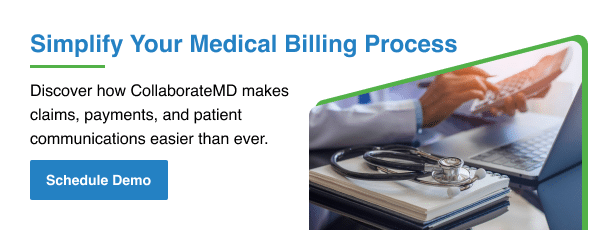Modern healthcare isn’t just about excellent clinical care and overall practice performance. With higher patient volumes, increasing claim complexity, and mounting financial pressure, practices must operate smarter. That’s why electric health record (EHR) integration is rapidly becoming an essential part of many medical practices.
A National Library of Medicine Study
Physicians Report:
- With reminders and alerts in EHR, quality and patient safety can be improved
- EHR enables reporting of adverse events
- It is easier to find patient data and easier to read their information clearly
Providers report that when EHRs are effectively integrated, they make their records more readily available at the point of care, enhancing accuracy and coordination and overall patient care. When integrated with powerful practice management tools, EHR data reveals patient trends, triggers preventive interventions, and streamlines every step of the care-to-collection journey.
CollaborateMD was built with integration in mind. With a platform that collects and connects data across billing, scheduling, clinical care, and patient communication, CollaborateMD allows your staff to focus on delivering better outcomes while we handle the behind-the-scenes complexities.
The Benefits of Seamless Electronic Health Record Integration
The true power of EHR integration is that it allows you to act faster, bill smarter, and provide better care. EHR data is more than digital paperwork; it’s a strategic asset that drives revenue, reduces overhead, and improves health outcomes.
Practices that fail to integrate are often left dealing with fragmented data, slow reimbursements, and avoidable patient risks. Those that embrace seamless EHR integration with solutions like CollaborateMD are setting a new standard for efficiency and care delivery. Here’s how:
Reduced Costs and Increased Revenue
Automated data syncing between your EHR and billing systems can significantly cut operational expenses. Practices using integrated platforms like CollaborateMD report improved claim accuracy and faster payment cycles, both key drivers of revenue growth. Our claim scrubbing tools and payer-specific rules help maximize first-pass resolution rates and minimize denied or delayed claims.
Enhanced Data Accuracy through Better Coordinated Care
CollaborateMD’s bi-directional EHR interfaces eliminate duplicate data entry, ensuring consistent and accurate patient records across clinical and administrative systems. With unified patient data, providers can collaborate more effectively and avoid miscommunication with less manual data entry, leading to greater continuity of care and better patient experiences.

Heightened Patient Outcomes through Data-driven Decisions
Access to real-time clinical data helps providers make faster, more accurate diagnoses. With CollaborateMD’s reporting tools, enterprise practices can track chronic conditions, flag high-risk patients, and deploy proactive interventions based on historical data. Properly integrated help clinicians identify and address potential safety problems when they occur, helping protect patients and leading them to better outcomes.
Improved Efficiency through Streamlined Workflows
Your staff is busy and should have more time to focus on care delivery, but there’s always more admin tasks to do, right? CollaborateMD automates front- and back-office processes like insurance verification, claims submission, and denial management, which are often time-consuming and error-prone when done manually. These automations cut administrative time and allow staff to focus on patient care rather than duplicate data entry.
Data-Driven Decision-making for Better Health Outcomes
Your practice needs visibility into patient care trends and operational KPIs. CollaborateMD’s customizable dashboards allow you to spot anomalies, track quality measures, and make data-backed decisions quickly.
Enhanced Patient Engagement and Communication
Patients who access their health information are more likely to stay engaged with their care, according to an article in JAMA Health Forum . CollaborateMD’s portal empowers patients to schedule appointments, receive automated reminders, view statements, and make secure payments.
EHRs that support patient access improve compliance, help reduce appointment no-shows, and open a secure communication portal between patients and providers, allowing increased communication convenience, accuracy, tracking, and flexibility.
CollaborateMD: Your Partner for Successful EHR Data Integration
“Collaborate” is more than just in our name, it’s our mantra. We are the behind-the-scenes teammate, supporting your clinical and administrative staff with a fully integrated solution.
Advanced Reporting and Analytics Capabilities
Monitor appointment trends, coding accuracy, reimbursement speed, and more, all from real-time, actionable and customizable dashboards that provide analysis and reporting on both clinical performance and financial health.
Read the blog: “Get More Done with Time-Saving Healthcare Technology.”

Data Security and Compliance
Data privacy is not optional. CollaborateMD meets HIPAA standards and includes audit trails, access controls, and regular system updates to protect patient data while keeping your practice operating in compliance. Updates are integrated, automatic, and help you avoid penalties and protect your reputation.
Automated Workflows to Reduce Manual Tasks
CollaborateMD’s automation suite includes real-time eligibility checks, electronic remittance advice auto-posting, denial tracking, and our own integrated clearinghouse. These tools reduce human error and accelerate time to reimbursement.
User-friendly Interface to Simplify Training and Implementation
With step-by-step training, dedicated customer support, and a robust knowledge center, you and your team can onboard quickly and scale confidently, even across multiple locations.
“Having access to that support was incredibly helpful… I could see that CollaborateMD understood what was involved — and that they were going to support the switch-over process.” — Howard Friedman, DPM, Suffern Podiatry (Read the full Case Study)
Best Practices for EHR Integration
To maximize the impact of your data and avoid costly disruptions, it’s critical to approach integration with a clear plan and cross-functional collaboration. By following these proven best practices, you can help your team achieve smoother onboarding, faster return on investment, and long-term gains in both clinical and operational performance.
Adoption and Adaptation
- Stakeholder Engagement: Involve your clinical and administrative leaders from day one.
- Phased Implementation: Roll out integrations gradually to avoid workflow disruptions.
- Continuous Improvement: Use real-time reporting to identify and resolve gaps.
- Automatic Updates: CollaborateMD handles system upgrades and keeps tools current without downtime.
Outcomes
- Streamlined Clinical Activities: Simplify provider workflows by automating routine tasks.
- Speed and Accuracy in Billing and Payment: Reduce claim errors to accelerate reimbursement.
- Quality of Care and Patient Safety: Improve patient care and safety through accurate and timely information sharing across systems and teams.
- Data-driven Decision Making: Leverage advanced analytics for evidence-based decisions and long-term planning.
Read more about EHR and EMR integration.
EHR Data Is One of the Most Powerful Tools for Your Practice
Successful EHR integration can drive better patient outcomes, accelerate reimbursement, and dramatically improve workflow efficiency.
CollaborateMD’s integrated, cloud-based platform helps practices effectively tap into their EHR data with superior usability features, security, and support.
Explore how CollaborateMD can support your practice’s transformation. Get started with a personalized demo today





